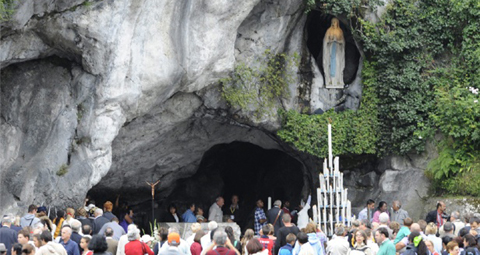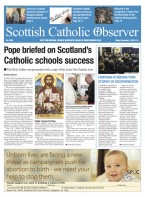August 10 | ![]() 0 COMMENTS
0 COMMENTS ![]() print
print

A healing place: why the world comes to Lourdes
ALAN GILLESPIE considers a range of moments, ministry and tatty memorabilia pilgrims face when they seek strength — By ALAN GILLESPIE
It’s still early, on a muggy morning in Lourdes, and the Basilica of St Pius X—the Underground Basilica—is filling up quickly. Over the next hour, worshippers will gather for the International Mass, held twice a week, in seven different languages. Standing inside this massive structure feels vaguely like being within an upturned boat, or maybe a giant ribcage. Huge concrete bones protect the altar which is placed strategically, and unusually, in the centre of the congregation.
The enormity of this concealed space is overwhelming. It is like an underground Hydro, a repurposed Noah’s Ark, and can apparently accommodate 25,000 souls. The stark, grey concrete walls should be oppressive but they’re not; there’s too much colour in the room, and most of it comes from the people.
There are battalions of volunteers wearing orange scarves, schoolgirls in blue hoodies, pensioners draped in lilac shawls. Other groups are identified by their distinctive hats in a myriad of colours. They are reminiscent of birds’ feathers; different flocks coming together.
Laura Murphy, a headteacher on a school pilgrimage, is making her third visit to Lourdes. “As a Catholic in Scotland, you often feel like you’re part of a minority religion,” she says. “But when you’re here, surrounded by all these people, you realise you’re actually part of something massive, something international. The whole world comes to Lourdes.”
Snuggled at the foot of the Pyrenees, in the south of France, Lourdes has become a magnet for the Catholic Faith since the Virgin Mary appeared to Bernadette Soubirous 18 times between 1858 and 1859. Mary instructed Bernadette to drink and bathe in the water flowing from a small spring in a cave, and it is in imitation of this holy cleansing that people journey to Lourdes.
The Catholic Church has officially recognised 70 miracles deriving from the healing qualities of this spring water, with the most recent in February 2018, however many thousands of undocumented miracles are also claimed.
The cave where Mary’s apparition appeared has become the Grotto, a shrine where Mass is hosted all day long.
There is vibrancy and joy in the Basilica for the International Mass, but also desperate suffering.
Worshippers in wheelchairs fill huge spaces in front of the altar, chaperoned by the ubiquitous volunteers from the hospitalité—these places are part-hotel, part-hospital. Dying patients are wheeled in on beds, buried beneath blankets, placed in front of the choir, as though warming by a fire. A priest furiously translates the Mass into sign language; a gorgeous big guide dog mischievously wags its talk and nuzzles its owner’s lap, paws at an itch, then sleeps soundly all the way through the service.
The whole event is organised by nuns in habits, manipulating the congregation more efficiently than any Hampden steward, medical bags attached to their waists. When it’s nearly time to begin, a cloud of priests comes rolling down the aisle: ancient ones, chubby ones, movie-star-handsome ones. More often than any others, you hear the words bravo, merci, and ssshhh.
The whole thing is filmed and played on big screens for those at the back of the congregation, with aerial close-ups of the intricate parts of the service. The camera deftly captures the priest’s wrinkled hands on the shining chalice; a swift zoom magnifies the Communion wafer to the size of the moon. You almost expect to see a slow-motion replay, or a contentious VAR decision.
“Since the very early days, Lourdes has been a place of pilgrimage, with a special focus on the sick and infirm,” said Fr Bernard Mournian, of St Columbkille’s Church in Rutherglen. “Even my own late grandfather in the 1960s was taken to Lourdes on a stretcher. It is a place where those who suffer can come to encounter the healing power of their Faith.”
Fr Mournian is a young priest, just 30 years old, with the voice of a lark and a predilection for cake and coffee. He is everything you might expect from a Catholic priest: devout, thoughtful, steeped in Liturgy, permanently dog-collared. But he is also a mischievous personality, full of songs and terrible dad jokes.
Following the Stations of the Cross, which recreate Jesus’ journey to Crucifixion on a hilltop overlooking Lourdes, Fr Mournian is solemn and sincere in that familiar, priestly way; then ends his final message with an eternally vital decree: “Now, let’s go get pizza.”
This combination of reverence and humour feels entirely natural in Lourdes. And it’s necessary: this is a place full of youngsters, and when it comes to engaging children in ideas of Faith, Fr Mournian carries himself like an old pro.
The hospitalités in Lourdes are amazing places, where the sick and disabled can reserve accommodation for their stay and receive the necessary healthcare at the same time.
You see volunteers pushing and pulling visitors along in three-wheeled carts at all hours of the day. Being fit and healthy while surrounded by such a high proportion of people who are clearly struggling makes you very aware of yourself, and very grateful.
People say that you should go to Lourdes before you have to, as though a visit out of desire rather than desperate need makes the place more pleasing. Fr Mournian is constantly aware of Lourdes’ symbolism for the many who are in the darkest moments of their lives, perhaps even perilously close to the end.
He said: “As human beings, we are all broken and in need of spiritual healing. We see this every day in Lourdes, in the concentration and piety of the people attending Holy Mass, waiting for Confession, those participating in the Rosary procession, and in the late-night silence when we encounter people in private prayer and reflection.
“Some of the sick people I spoke with said they always left Lourdes feeling renewed, their Faith in humanity restored. This is due to the dignity and respect they are treated with.”
An entire micro-economy of Mary merchandise has sprung up around Lourdes. Pilgrims can buy Mary Mints, Mary statues of every conceivable size and colour, mugs, coasters, shot glasses; there are even rumours of a themed toilet roll dispenser, which tinkles out Ave Maria along with the Andrex.
Combined with the postcard-perfect Basilica of Our Lady of the Immaculate Conception, which gazes cheerfully across the Sanctuary, the impression is of a Catholicised Disneyland, with Mary replacing Mickey as the central icon.
There can be something a little uneasy about the way Lourdes combines profiteering with reverence.
This is a final solace for some of the world’s most desperate people, which simultaneously punts Mary memorabilia with levels of enthusiasm that would make the most fervent Blackpool conman shudder. Fr Mournian however feels that these two worlds coexist comfortably.
“Many people are put off by the commercialisation surrounding the Grotto. The roads are strewn with tawdry souvenir shops, but it’s all part of the package. Being a priest of discerning taste, I tend to avoid it, however if you look in the right places you can pick up some worthy mementos. Everyone likes to take a home a token as a reminder of their pilgrimage.”
Chief amongst the options for these trinkets is a personal supply of holy water, which is collected in reservoirs below the town and pumped to various rows of taps. The shops will sell you containers to fill up, from tiny wee ones to vast, Lourdes-branded five-litre ones. The spring water is also siphoned into the Baths, where you can queue to be wrapped in a sheet and dunked right up to the chin in the freezing stuff.
You begin to realise that it’s not only the suffering souls in the carts who are looking for something special to happen. “I felt like I needed Lourdes just now,” says one pilgrim. “I’m not here praying for any specific miracle, but with everything that’s going on in my life I really needed Lourdes. I’ve been looking forward to this.”
Many visitors to Lourdes won’t need the hospitalités, or volunteer-drawn carts, but just because they don’t look sick doesn’t mean they aren’t. That seems to be the real miracle here, although it might not make it into the brochures.
People who are internally struggling with family problems, grief or whatever else makes life harder than it should be get the space, time and permission to look inwards, to go home feeling loved and refreshed.
For Fr Mournian, the pilgrimage from Rutherglen to Lourdes is a privilege. He takes part in the International Mass, and another English-language Mass inside the Grotto itself. He said: “I’m very aware that for many in Scotland, it’s quite rare that young people come together in such numbers to celebrate Mass. For those youngsters who practise their Faith, they appear to be small in number. It’s liberating to be able to witness this happening in Lourdes.”
This beautiful little town is a baffling, wonderfully weird place; but it is a place of togetherness, of camaraderie and joy. It is also a place of refuge, which gives some of those who visit a much-needed sparkle of hope. Every day in Lourdes ends with the Marian Torchlight Procession, with thousands of worshippers taking part; a river of candlelight flows around the sanctuary, everyone singing Ave Maria, flickering flames held high in the air. And here, in this madness, it doesn’t matter if you’re sick or healthy. It doesn’t even really matter if you believe in God.
There’s just something a wee bit magical about being here, with your fellow humans, singing in harmony and trying to stop the candles from blowing out.











